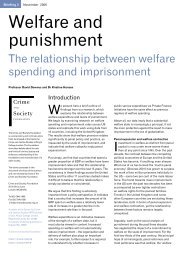PRISON SERVICE
PRISON SERVICE
PRISON SERVICE
- No tags were found...
Create successful ePaper yourself
Turn your PDF publications into a flip-book with our unique Google optimized e-Paper software.
essence, parole and release can nolonger be assessed in just a UKcontext.The following 13 chapterstherefore provide an invaluablesurvey of the situation regardingthe rules of release for a number ofEuropean countries. The countriesincluded in this analysis are: Austria,Belgium, England and Wales,Finland, France, Germany, Greece,Ireland, Italy, The Netherlands,Scotland, Slovenia and Spain. Eachchapter therefore provides asummary of the current law,historical influences and anevaluation of existing research andstatistical data; all written byleading academics andcommentators.Finally, in part three, is aconcluding chapter which not onlytries to bring everything togetherbut also, additionally, includesinformation from other countriesnot listed above. In easy to readtabular form, early release fromdeterminate sentences ofimprisonment is catalogued andcompared; with additions includingCroatia, Czech Republic, Denmark,Estonia, Hungary, Lithuania, Poland,Romania, Russia, Sweden andSwitzerland. This brings the totalanalysis to 24 European Countries.The final chapter also considers theextent to which a ‘coherent and fairpolicy on release from prison isdeveloping within the EU’ andanalyses the challenges to thisendeavour.Release from Prison. Europeanpolicy and practice is therefore amuch needed and importantaddition to the literature on paroleand release. Not only does it havean impressive array of contributorsit is on its own in respect of thebreadth and depth of subjectmatter it offers. If you are interestedin comparative research in this area,this is a definite ‘must have’.Dr. Karen Harrison is a Lecturer inLaw at the University of Hull.Book ReviewManaging High-Risk SexOffenders in the CommunityEdited by Karen HarrisonPublisher: Willan PublishingISBN: 978-1-84392-526-2(paperback) 978-1-84392-525-5(hardback)Price: £26.00 (paperback) £62.00(hardback)For somebody who hasworked with sex offenders for over15 years, this book brought hometo me the considerabledevelopments we haveexperienced within that period interms of our working practiceswith this group of offenders. Withan aim to identify methods forpreventing further sexualvictimisation, the editor KarenHudson who lectures in Law at HullUniversity has managed toassemble a wide range of writingsfrom experts within their fields thatboth chart this development andreview most if not all of themeasures that are now available totreat and manage sex offenders inthe community, particularly thosethat present a high level of risk.The cover note describes thisbook as essential reading for policymakers, professionals working inthe field of sexual abuse andinterested academics. However forthe wider audience it struck mehow valuable some of themessages were in terms of theirpotential for providing aninformed view of what works inthe management of sex offendersand a possible antidote to themoral panic that the popular pressseems to be able to generatearound this subject, a theme whichits contributors regularly commentupon throughout this book.Assembled within five distinctsections the reader is firstintroduced to a discussion on‘paedophilia’ and the differencesin the definition of the term,before moving onto consider froma NOMS perspective, under theguidance of Ruth Mann and MarkFarmer the policy issues facingthose within offendermanagement who deal with thisgroup of offenders.Risk Management measuresand their effectiveness, suchas MAPPA proceduresand Registration/Notificationrequirements are reviewed in thesecond section, before section threeintroduces the reader to the mainprovisions for treatment and riskreduction, including treatmentprogrammes, pharmacotherapy(drug and medical basedinterventions) and finally restorativejustice initiatives such as Circles ofSupport and Accountability.The fourth section of the bookreminds us that sex offenders arenot a homogenous group andprovides some detailed writings inspecific areas. The opening chapterby Franca Cortini focuses onfemale sex offenders and the needfor a better understanding of theirrisk assessment, management andtreatment needs. Sexually abusivebehaviour by youths mentallydisordered and intellectuallydisabled individuals are also putunder the spotlight in subsequentchapters with interesting practiceperspective being provided fromplaces such as the Netherlands andUSA to name just a few.The concluding sectionreviews the emergence of on-lineoffending by examining patterns,prevention and protection, beforeKeiran McCartan then leads thereader through a discussion on themedia and the way it has shapedattitudes opinion and ultimatelyGovernment strategy. Finally andmost appropriately the last chapteraddresses the premise that therights of the individual sexoffender we work with must bebalanced against the need forcommunity protection.Managing High Risk SexOffenders in the Community isboth informing and balanced in itspresentation of the methods we62 Prison Service JournalIssue 192











